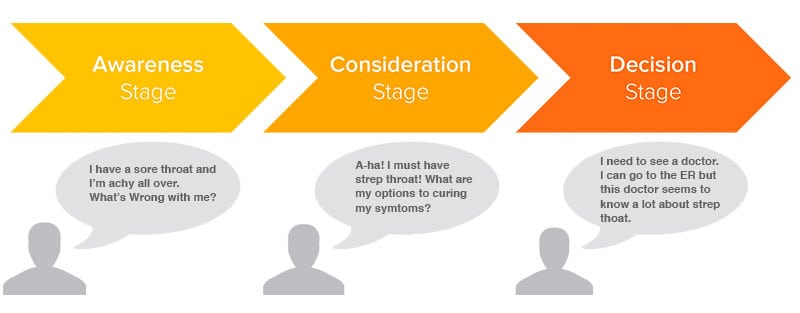Topics
Inbound Marketing for Doctors: Why It’s Important and What You Need to Know

As a direct primary care physician (DPC) – or any physician really – the last thing that you want to worry about is developing a marketing strategy or figuring out how to reach more people and grow your patient panel.
You went to school for medicine, after all, and there are conflicting marketing tools, strategies, and best practices coming out practically every day – which means that it’s hard to know exactly what information to believe or where to start.
That said, you can’t just ignore it altogether: developing and executing a high-performing marketing strategy is an essential part of any successful practice, particularly if you’re not passively getting leads from insurance databases or other network channels.
So, what do you need to know and how do you get it right?
In a word – inbound marketing. Here’s why the inbound methodology is a game-changer and what you need to know to get started today.
Inbound vs Traditional Outbound Marketing
Traditional Outbound Marketing
With traditional outbound marketing, the idea is to project and get your message in front of as many eyes as possible in the hopes that it will reach the right audience. This is usually done through things like:
● Networking for referrals
● Print ads
● Email blasts
● TV or radio appearances
● Display ads and pay-per-click (PPC) advertisements
All of these strategies can certainly help you generate interest and get new prospective patients, but they have major drawbacks. Networking and print ads, in particular, require a ton of time and manpower, and they can be really difficult and costly to target. Similarly, PPC advertisements can get really expensive – plus, when you stop the ads, you also stop getting leads, meaning they have very low ROI.
The Inbound Marketing Difference
Today, 90% of all product or service purchases start on the internet, including the search for the right doctor. Inbound marketing is the art and science of building awareness of your practice on the internet so that you can attract potential patients to your website and convert them to grow your patient panel.
The main methodology? To attract, engage, and delight your prospects by creating interesting, relevant, and timely content that they are already searching for – thereby encouraging them to find you organically.
How do you do this?
You create an online presence that’s full of content that answers your target audience’s questions and speaks to their interests. This will showcase you as an expert and illustrate that you can provide the exact information and services that they’re looking for, which will ultimately build trust and credibility for your practice.
It’s marketing based on true value and service, rather than attention-grabbing and gimmicks. In the long run, this is more cost-effective than traditional outbound practices, and it has a measurable return on investment (ROI) that you won’t find with other strategies.
Let’s dive in a little deeper.
Understanding Inbound Marketing: The Basics
The Philosophy: Attract, Engage, Delight
With the inbound methodology, your goal is to:
● Attract your target market – people that are likely to become long-term, loyal patients – with content that they find helpful, relevant, and interesting. That means creating a website, blog, and/or social media presence that answers their questions, addresses their pain points, and piques their interest no matter what stage of the buyer’s journey they may be in (more on that below).
● Engage and convert them by asking for their information – an email address or phone number, for example – in exchange for the high-quality, valuable information that you attract them with. This is absolutely essential: if you don’t have any way of reaching them or developing a relationship, you won’t have a new patient.
● Delight them by creating personalized, intuitive communication and experiences – like personalized follow-up interactions, informational blogs, or product suggestions – that make them feel special or make their lives easier. This will not only improve your relationship with the prospect, but also promote positive word-of-mouth recommendations and positive reviews.
In the big picture, this 3-step methodology builds the know, like, and trust factor, which helps you stand out from the competition and cultivate long-term, healthy relationships.
Other Essentials: Buyer Journey and Personalized Segmentation
Now, while the overarching methodology will always stay the same, how it looks can vary drastically depending on what service a particular visitor is looking for and where they are in the buyer’s journey. Here’s what that means.
There are three stages to the buyer’s journey:
● Awareness: The person realizes they have a problem a.k.a they realize that they need medical attention or that their current needs are not being met.
● Consideration: They define their problem and research solutions to solve it. This is where they could be comparing various doctors or treatment options.
● Decision: They choose a solution.

Someone who has identified a medical condition and is deciding on which doctor to use, for example, is in the decision stage, and they will want very different information than someone who’s visiting your website for the first time and looking for general health and wellness facts i.e. someone who is in the awareness stage.
Properly identifying where your audience members are in the buyer’s journey is extremely important if you want to optimize your communication and send the right message to the right person at the right time. That said, it’s not the only factor that you have to be aware of.
It’s also equally important to segment your audiences by identifying their primary interests and figuring out exactly who they are and what information they’re looking for right at the first interaction. This can be done with marketing automation that tracks things like what blog subscriptions, downloaded e-books, what website pages they visit, etc. That way, you can work them down the funnel – taking them from awareness to decision – with information that they are interested in, thereby building a more personalized, successful long-term relationship with every person that visits your content.
This may sound like a step that you can skip, but trust us – it’s not. Some interesting facts:
● On average, marketers see a 20% increase in sales when using personalized experiences.
● 74% of customers feel frustrated when a website’s content is not personalized.
● According to MailChimp, segmented email marketing campaigns get 14.64% more email opens and a whopping 59.99% more clicks than non-segmented campaigns
● Relevant emails drive 18 times more revenue than broadcast emails.
● 79% of consumers say they are only likely to engage with an offer if it has been personalized to reflect previous interactions the consumer has had with the brand.
The point? Not only does segmentation and understanding your audience matter – audiences today simply won’t accept anything less. So you have to get this part right if you don’t want to sacrifice potential engagement or lose a patient altogether.
If this sounds difficult to do on your own – or if you’d like some help with getting started – just let us know. We specialize in digital marketing for doctors and can guide you through the steps of building a successful strategy today.
Subscribe To Our Blog!

